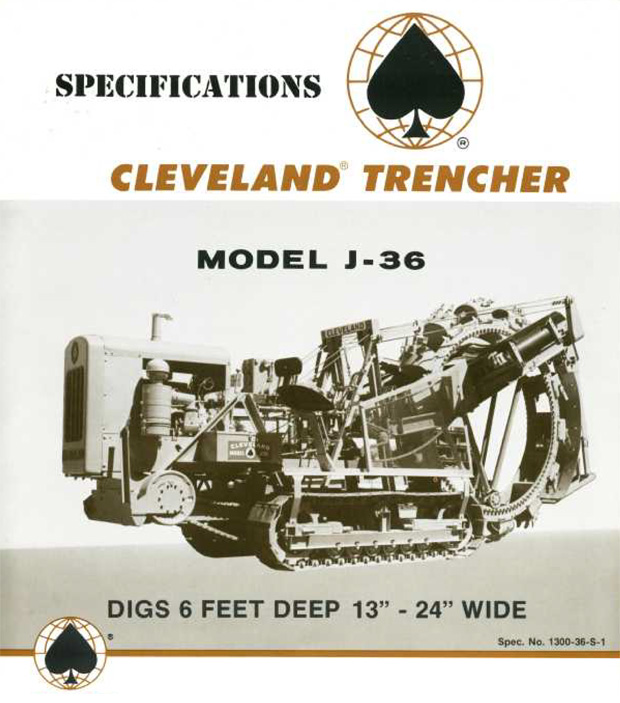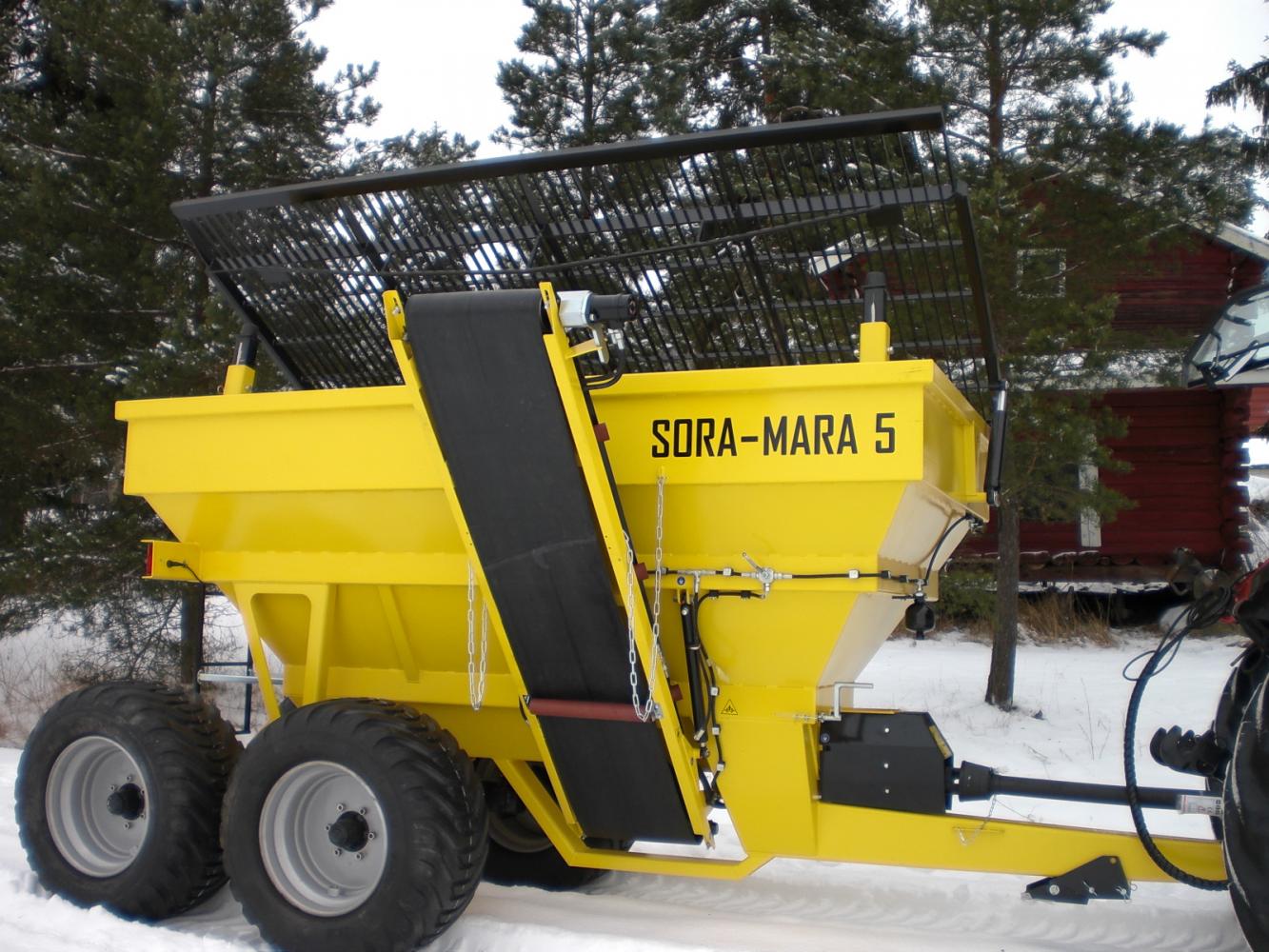Seuraavien kolmen vuosikymmenen aikana nämä ojienkaivamiseen erikoistuneet kaivinkoneet olivat yleisiä teollisuuskohteissa, tienrakentamisessa, asunto- tuotannossa ja kaikissa paikoissa missä putki-linjoja oli tarkoitus laittaa maahan.
Kun traktori-kaivuri tuli markkinoille 1950-luvulla ja nykyään suositut kompaktit kauha-kaivukoneet, suurien ojitus yhtiöiden ostot vähenivät suurien maakohtaisten putkijohtojen töiden osalta joilla on sopivat geologiset olosuhteet ja esteetön maaperä, muut ei voineet kilpailla kiekkokauha-kaivukoneiden ylivoimaista tuotantoa vastaan.

Yksi merkittävä oja-koneiden valmistaja joka on erikoistunut vain tällaisiin laitteisiin, on Cleveland Trencher Co.
Vuonna 1921 urakoitsija A.J. Clevelandin vesi- ja viemäröintiurakoitsija Penote Co. rakensi pienen kauha-pyörän Detroitissa. Saatuaan monia kyselyjä tämän onnistuneen koneen jälkeen yhtiö päätti alkaa valmistaa ja myydä sitä. Cleveland Trencher Co. perustettiin vuonna 1923. Yksi ensimmäisistä ojituskoneista oli 1924 "Baby Digger" joka auttoi luomaan yrityksen maineen lujiina, luotettavina koneina.
Cleveland Baby Digger oli pyörätyyppinen kaivukone, jossa 10 kauhaa kiinnitettynä pyörivälle pyörä-kehälle. Kaivinkoneen kaikki liikkeet siirrettiin mekaanisesti koneen asianmukaisiin osiin ketjujen ja vaihteiden välityksellä. Kaivuu-pyörää ajettiin parilla hammaspyörällä, jotka olivat hammasrattaiden päällä pyörän ulkosivuilla, kaivinta nostettiin ja laskettiin vaijereilla jotka oli asennettu kierto-rummuille. Kaivuumaiden kuljetin voitiin kääntää purkamaan koneen molemmille puolille, ja sitä käytettiin ketjulla kaivukoneen ohjaamosta.

Tällä tavoin kuljetin toimi aina aina kun kaivuupyörä pyöri. Telaketjujen veto tapahtui ketjuilla ja ketjupyörillä tasauspyörästön välityksella ja ohjaus tapahtui takimmaisen käyttöakselin päissä olevilla jarruilla. Kauha-pyörä pystyi kaivamaan 30 - 60 cm leveitä ojia enintään 180 cm syvyyteen. Teho tuli Herculesin 27hv moottorista ja kone oli kevyt, sen paino oli vain 7 400 kiloa, minkä ansiosta se pystyi työskentelemään pehmeällä maaperällä ja betonisilla jalkakäytävillä vahingoittamatta niitä.
Vuosikymmenien aikana Baby Diggerin teho ja kapasiteetti kasvoivat, ja päivitetyt versiot olivat edelleen osa Clevelandin linjaa jo 1950-luvulla.
Vuosina 1968-1984 Cleveland Trencher omisti amerikkalaisen Hoist & Derrick Co: n St. Paul, Minn., Ja sen jälkeen hallinnointiyhtiö buyout-tiimi vuoteen 1986 asti. Vuonna 1987 Clevelandin jälleenmyyjä osti Keski- Itä ja Kauko-idässä yritykset,
mutta koneita valmistetaan nykyään alkuperäisessä Clevelandin tehtaassa.
CLEVELAND TRENCHER
"Baby Digger" auttoi muuttamaan ojan kaivamisen selkärankaa rasittavasta työstä nopeaan ja kevyempään toimintaan.
Keith Haddock, toimittaja

Ford 5000 + Ketju-Mara, Valmistaja Kurpan Konepaja Loimaa Finland

MF-65 + Ketju-Mara Valmistaja Kurpan Konepaja Loimaa Finland

Ford 5000 + Ukko-Mara, Valmistaja Kurpan Konepaja Loimaa Finland

Valmet 1102 + Ukko-Mara, Valmistaja Kurpan Konepaja Loimaa Finland

Sora-Mara Valmistaja Kurpan Konepaja Loimaa Finland

Agrosa Oy, on 2008 perustettu suomalainen maatalouskoneita ja -tarvikkeita valmistava ja markkinoiva yritys.
Sora-Mara, Uusi malli, Valmistaja Agrosa Oy / 32200 Loimaa
-----------------
Toisen maailmansodan jälkeen perustettiin Puolustuslaitoksen Santahaminan tehdas, jossa rakennettiin työkoneita pääasiassa siviilikäyttöön
Liittoutuneiden ylijäämävarastoista ostettiin yhdysvaltalaisia White M2 -puolitela-autoja muutettiin salaoja-kaivukoneiksi (field trencher) nosturiautoiksi, kompressorivaunuiksi ja kivenraivauskoneiksi vuoteen 1955 saakka.
White M2 Half-Track
After the Second World War, the Santahamina Factory, the Finnish Defens Facility was established, where non-road machinery was built mainly for many civil use.
US White M2 Half-Track trucks are very favority, 435 car were bought and modifielded
and chances to crane trucks, compressor wagons and rock trimmers, until by 1955.
--------------
xxxxxxxxxxxxxxxxxxxxxxxxxxxxxx
https://youtu.be/MXvwJEEFZFI
During the 1920s, trench digging was transformed from back-aching hand labor to mechanized continuous operation by several enterprising individuals who invented and marketed specialized trenching machines. Over the next three decades, specialized trench excavators were commonplace on industrial sites, road construction, housing developments, and wherever pipes had to be laid. 
Ford 5000 + Ukko-Mara, Valmistaja Kurpan Konepaja Loimaa Finland

Valmet 1102 + Ukko-Mara, Valmistaja Kurpan Konepaja Loimaa Finland
Sora-Mara Valmistaja Kurpan Konepaja Loimaa Finland

Agrosa Oy, on 2008 perustettu suomalainen maatalouskoneita ja -tarvikkeita valmistava ja markkinoiva yritys.
Sora-Mara, Uusi malli, Valmistaja Agrosa Oy / 32200 Loimaa
-----------------
Toisen maailmansodan jälkeen perustettiin Puolustuslaitoksen Santahaminan tehdas, jossa rakennettiin työkoneita pääasiassa siviilikäyttöön
Liittoutuneiden ylijäämävarastoista ostettiin yhdysvaltalaisia White M2 -puolitela-autoja muutettiin salaoja-kaivukoneiksi (field trencher) nosturiautoiksi, kompressorivaunuiksi ja kivenraivauskoneiksi vuoteen 1955 saakka.
White M2 Half-Track
After the Second World War, the Santahamina Factory, the Finnish Defens Facility was established, where non-road machinery was built mainly for many civil use.
US White M2 Half-Track trucks are very favority, 435 car were bought and modifielded
and chances to crane trucks, compressor wagons and rock trimmers, until by 1955.
--------------
xxxxxxxxxxxxxxxxxxxxxxxxxxxxxx
https://youtu.be/MXvwJEEFZFI
With the advent of the loader-backhoe in the 1950s, and the popular compact utility trenchers of today, markets for the big ditchers diminished. But for big cross-country pipeline jobs, with the right geological conditions and free of obstructions, nothing can compete with the continuous production of a ditching machine. One prominent ditcher manufacturer that has always specialized in this kind of equipment is Cleveland Trencher Co.
Back in 1921, contractor A.J. Penote Co., a water-and-sewer contractor from Cleveland, built a small wheel ditcher for a job in Detroit. Following many inquiries about this successful machine, the company decided to manufacture and sell it, and the Cleveland Trencher Co. was established in 1923. One of the first ditching machines produced was the "Baby Digger" of 1924, which helped to establish the company's reputation for tough, reliable machines.
The Cleveland Baby Digger was a wheel-type trencher with 10 buckets attached to the circumference of the wheel. All motions of the trencher were mechanically transmitted to the appropriate parts of the machine through chains and gears. The wheel was driven by a pair of spur gears meshing with teeth on the outer sides of the wheel, and the digging structure was hoisted and lowered by cables wound on worm-driven drums. The conveyor, which could be set to discharge to either side of the machine, was driven by chain from the digging wheel drive shaft.
In this way, the conveyor always functioned whenever the wheel turned. The crawler tracks were driven by chains and sprockets through a differential drive with steering accomplished through wrap-around brakes on the final drive shafts. It could dig trenches from 10 to 23 inches wide to a maximum depth of 5 feet 6 inches. Power came from a Hercules 27-hp engine, and the machine's light weight of 7,400 pounds enabled it to work on soft ground and cement sidewalks without damaging them.
Over the decades, the Baby Digger's power and capacity were increased, and upgraded versions were still part of Cleveland's line well into the 1950s.
From 1968 to 1984, Cleveland Trencher was owned by American Hoist & Derrick Co. of St. Paul, Minn., and then by a management buyout team until 1986. In 1987, the company was bought by the owner of Cleveland's distributor for the Middle East and Far East, but the machines continue today to be made in the original Cleveland plant.
CLEVELAND TRENCHER
"Baby Digger" helped change ditch digging from back-breaking labor to high-speed operation
By Keith Haddock, Contributing Editor
Ei kommentteja:
Lähetä kommentti